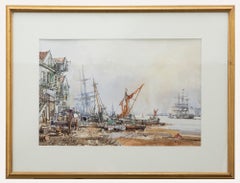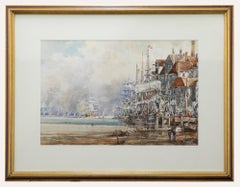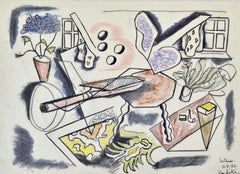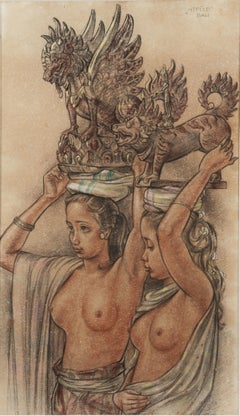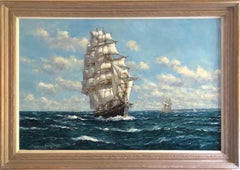John Sutton Art
to
4
2
3
1
2
2
Overall Height
to
Overall Width
to
2
1
1
1
1
4
2
4
6,886
3,210
2,514
1,217
3
3
1
1
Artist: John Sutton
John Sutton (b.1935) - Framed 20th Century Watercolour, Loading the Ships
By John Sutton
Located in Corsham, GB
A dramatic harbour scene by the British marine and landscape artist John Sutton. Many hands can be seen along the cobbled sidewalk, loading and unloading a multitude of ships at low ...
Category
20th Century John Sutton Art
Materials
Watercolor
John Sutton (b.1935) - Framed 20th Century Watercolour, Ships in the Sea Port
By John Sutton
Located in Corsham, GB
A dramatic and busy shipping port scene by the British marine and landscape artist John Sutton. Signed in pencil to the lower left edge. Well-presented in a fine gilt-effect frame wi...
Category
20th Century John Sutton Art
Materials
Watercolor
Mid 20th Century British Cubist watercolour drawing by John Sutton
By John Sutton
Located in London, GB
JOHN SUTTON
(20th Century)
Still Life with Fruit
Signed, inscribed and dated: 10/5/42
Watercolour, chalks and pen and ink, unframed
25 by 31.5 cm., 10 by 12 ½ in.
(mount size 40 ...
Category
1940s Cubist John Sutton Art
Materials
Watercolor, Chalk
Interior - 1940s Cubist chalk drawing of an interior still life by John Sutton
By John Sutton
Located in London, GB
JOHN SUTTON
(20th Century)
Interior
Signed, inscribed with title and dated: 12/5/42
Watercolour and chalks, unframed, in mount only
25 by 34.5 cm., 10 by 13 ½ in.
(mount size 40 ...
Category
1940s Cubist John Sutton Art
Materials
Crayon
Related Items
Two Seated Men
By Henri Lebasque
Located in New York, NY
“Two Seated Men” by Henri Lebasque (1865-1937)
Pencil and watercolor on paper
6 x 5 inches unframed (15.24 x 12.7 cm)
Signed on bottom right
Description:
In ...
Category
20th Century John Sutton Art
Materials
Watercolor, Pencil
Two Balinese Beauties (Mapeed), circa 1945
By Johan Rudolf Bonnet
Located in Amsterdam, NL
Rudolf Bonnet (1895-1978)
'Mepèèd' (Mapeed)
Signed lower right
Titled upper right
Pastel on gouache pigmented paper, 57 x 34 cm
In original carved ebo...
Category
1940s John Sutton Art
Materials
Paper, Crayon, Pastel, Gouache, Pencil
Free Shipping
H 22.45 in W 13.39 in D 0.04 in
Mid Century Modern Cubist Mandolin Abstract Still Life
Located in Soquel, CA
Cubist composition of a mandolin and other objects by unknown artist (Helen) Solter (American, 20th Century). Signed "SOLTER" in the lower right corner. Unfinished painting...
Category
1960s Cubist John Sutton Art
Materials
Paper, Watercolor
The Abduction of the Sabine Women , a Renaissance drawing by Biagio Pupini
Located in PARIS, FR
This vigorous drawing has long been attributed to Polidoro da Caravaggio: The Abduction of the Sabine Women is one of the scenes that Polidoro depicted between 1525 and 1527 on the façade of the Milesi Palazzo in Rome. However, the proximity to another drawing inspired by this same façade, kept at the Ecole des Beaux-Arts, and to other drawings inspired by Polidoro kept at the Musée du Louvre, leads us to propose an attribution to Biagio Pupini, a Bolognese artist whose life remains barely known, despite the abundant number of drawings attributed to him.
1. Biagio Pupini, a Bolognese artist in the light of the Roman Renaissance
The early life of Biagio Pupini, an important figure of the first half of the Cinquecento in Bologna - Vasari mentions him several times - is still poorly known. Neither his date of birth (probably around 1490-1495) nor his training are known. He is said to have been a pupil of Francesco Francia (1450 - 1517) and his name appears for the first time in 1511 in a contract with the painter Bagnacavallo (c. 1484 - 1542) for the frescoes of a church in Faenza. He then collaborated with Girolamo da Carpi, at San Michele in Bosco and at the villa of Belriguardo.
He must have gone to Rome for the first time with Bagnacavallo between 1511 and 1519. There he discovered the art of Raphael, with whom he might have worked, and that of Polidoro da Caravaggio. This first visit, and those that followed, were the occasion for an intense study of ancient and modern art, as illustrated by his abundant graphic production.
Polidoro da Caravaggio had a particular influence on the technique adopted by Pupini. Executed on coloured paper, his drawings generally combine pen, brown ink and wash with abundant highlights of white gouache, as in the drawing presented here.
2. The Abduction of the Sabine Women
Our drawing is an adaptation of a fresco painted between 1525 and 1527 by Polidoro da Caravaggio on the façade of the Milesi Palace in Rome. These painted façades were very famous from the moment they were painted and inspired many artists during their stay in Rome. These frescoes are now very deteriorated and difficult to see, as the palace is in a rather narrow street.
The episode of the abduction of the Sabine women (which appears in the centre of the photo above) is a historical theme that goes back to the origins of Rome and is recounted both by Titus Livius (Ab Urbe condita I,13), by Ovid (Fasti III, 199-228) and by Plutarch (II, Romulus 14-19). After killing his twin brother Romus, Romulus populates the city of Rome by opening it up to refugees and brigands and finds himself with an excess of men. Because of their reputation, none of the inhabitants of the neighbouring cities want to give them their daughters in marriage. The Romans then decide to invite their Sabine neighbours to a great feast during which they slaughter the Sabines and kidnap their daughters.
The engraving made by Giovanni Battista Gallestruzzi (1618 - 1677) around 1656-1658 gives us a good understanding of the Polidoro fresco, allowing us to see how Biagio Pupini reworked the scene to extract this dynamic group.
With a remarkable economy of means, Biagio Pupini takes over the left-hand side of the fresco and depicts in a very dense space two main groups, each consisting of a Roman and a Sabine, completed by a group of three soldiers in the background (which seems to differ quite significantly from Polidoro's composition).
The balance of the drawing is based on a very strongly structured composition. The drawing is organised around a median vertical axis, which runs along both the elbow of the kidnapped Sabine on the left and the foot of her captor, and the two main diagonals, reinforced by four secondary diagonals. This diamond-shaped structure creates an extremely dynamic space, in which centripetal movements (the legs of the Sabine on the right, the arm of the soldier on the back at the top right) and centrifugal movements (the arm of the kidnapper on the left and the legs of the Sabine he is carrying away, the arm of the Sabine on the right) oppose each other, giving the drawing the appearance of a whirlpool around a central point of support situated slightly to the left of the navel of the kidnapper on the right.
3. Polidoro da Caravaggio, and the decorations of Roman palaces
Polidoro da Caravaggio was a paradoxical artist who entered Raphael's (1483 - 1520) workshop at a very young age, when he oversaw the Lodges in the Vatican. Most of his Roman work, which was the peak of his career, has disappeared, as he specialised in facade painting, and yet these paintings, which are eminently visible in urban spaces, have influenced generations of artists who copied them abundantly during their visits to Rome.
Polidoro Caldara was born in Caravaggio around 1495-1500 (the birthplace of Michelangelo Merisi, known as Caravaggio, who was born there in 1571), some forty kilometres east of Milan. According to Vasari, he arrived as a mason on the Vatican's construction site and joined Raphael's workshop around 1517 (at the age of eighteen according to Vasari). This integration would have allowed Polidoro to work not only on the frescoes of the Lodges, but also on some of the frescoes of the Chambers, as well as on the flat of Cardinal Bibiena in the Vatican.
After Raphael's death in 1520, Polidoro worked first with Perin del Vaga before joining forces with Maturino of Florence (1490 - 1528), whom he had also known in Raphael's workshop. Together they specialised in the painting of palace façades. They were to produce some forty façades decorated with grisaille paintings imitating antique bas-reliefs.
The Sack of Rome in 1527, during which his friend Maturino was killed, led Polidoro to flee first to Naples (where he had already stayed in 1523), then to Messina. It was while he was preparing his return to the peninsula that he was murdered by one of his assistants, Tonno Calabrese, in 1543.
In his Vite, Vasari celebrated Polidoro as the greatest façade decorator of his time, noting that "there is no flat, palace, garden or villa in Rome that does not contain a work by Polidoro". Polidoro's facade decorations, most of which have disappeared as they were displayed in the open air, constitute the most important lost chapter of Roman art of the Cinquecento. The few surviving drawings of the painter can, however, give an idea of the original appearance of his murals and show that he was an artist of remarkable and highly original genius.
4. The façade of the Milesi Palace
Giovanni Antonio Milesi, who commissioned this palace, located not far from the Tiber, north of Piazza Navona, was a native of the Bergamo area, like Polidoro, with whom he maintained close friendly ties. Executed in the last years before the Sack of Rome, around 1526-1527, the decoration of Palazzo Milesi is considered Polidoro's greatest decorative success.
An engraving by Ernesto Maccari made at the end of the nineteenth century allows us to understand the general balance of this façade, which was still well preserved at the time. The frescoes were not entirely monochrome, but alternated elements in chiaroscuro simulating marble bas-reliefs and those in ochre simulating bronze and gold vases...
Category
16th Century Old Masters John Sutton Art
Materials
Ink, Gouache, Pen
Old Master Drawing, 17th Century, Italian Art, Peace, Allegory, Love, Dove
Located in Greven, DE
Oak Leaf Peace Wreath with Dove and Serpent
Around 1700
Black chalk on thin, brownish paper
39,8 x 52,7 cm
Inscribed "N" in the centre left
This drawing is probably by an Italian Ar...
Category
17th Century Baroque John Sutton Art
Materials
Paper, Chalk
Nag Arnoldi , Switzerland - Drawings (1974) : Falling Icarus and Crouching Angel
By Nag Arnoldi
Located in Meinisberg, CH
Nag Arnoldi
(Swiss, * 18.9.1928 Locarno, † 10.2.2017 Lugano)
1. Falling Icarus
• Drawing - Mixed media (Indian ink, coloured pencil & gouache) on paper ca. 22 x 26 cm
• Signiert & ...
Category
Late 20th Century Abstract Expressionist John Sutton Art
Materials
Paper, India Ink, Gouache
Free Shipping
H 8.67 in W 10.24 in D 0.4 in
Gustav Melcher ( German, 1898 -?) Boats off Venice Italy Ink Water Color c. 1918
By Gustav Melcher
Located in Meinisberg, CH
Gustav Melcher
(German, 1898-?)
Segelschiffe vor Venedig - Sailing ships off Venice
• India ink, water colour wash
• Visible image ca. 11.5 x 18 cm
• Glased Frame ca. 20 x 25 cm
• Verso various inscriptions
• Signed lower right
Gustav Melcher was a German painter and a pioneer in film, film criticism and film theory and created this clever little picture of the skyline of Venice with various vessels.
Going by the various inscriptions an the backing paper, this drawing was made in 1918 when Gustav was twenty years old and passed on three years later to Gertrud Melcher on the 1. 2. 1921. I have no reasons to doubt this information. The small drawing is still in its unopened frame, so maybe there is more information to be discovered , however this will be the privilege of the next owner.
The picture also has retained its original antique frame – note that it has lost over the years various sections of the gesso decoration.
The very precisely executed drawing is most enjoyable to look at and doing so, remember you are looking through the eyes of a young man, who saw this foreign sea cape over a century ago.
Thank you for your interest and please note, that I offer free worldwide shipping on all my items.
Gustav Melcher began his studies at the Düsseldorfer Kunstakademie under Peter Janssen and Eduard von Gebhardt. Originaly he was interested in figurative and portrait painting, but after time he decided to pursue the depiction of land- and marinescapes. Durin his studies the young artist undertook trips to visit England, Scotland, Belgium and France and he joined the artist society Malkasten. It was in those days he would hold speeches to his colleges about this new invention called ‘Kintopp’ – Melcher was a great advocate of the moving pictures...
Category
1910s Naturalistic John Sutton Art
Materials
India Ink, Paper, Watercolor
Gustav MelcherGustav Melcher ( German, 1898 -?) Boats off Venice Italy Ink Water Color c. 1918, 1918
Free Shipping
H 7.88 in W 9.85 in D 0.79 in
Window onto the Sea, Original Drawing, Contemporary Landscape, Architecture
Located in AIX-EN-PROVENCE, FR
Work : Original Drawing, Handmade Artwork, Unique Work. The work has been treated with UV-resistant varnish and it is not framed.
Medium : Watercolour, Soft Pastel and Oil based col...
Category
21st Century and Contemporary Impressionist John Sutton Art
Materials
Archival Paper, Color Pencil, Pastel, Watercolor
H 11.82 in W 11.82 in D 0.12 in
Study after Michelangelo’s “The Last Judgment”
By Michelangelo Buonarroti
Located in New York, NY
Italian School, 16th Century
Provenance:
Private Collection, New York
This intriguing drawing is a study by an anonymous 16th-century Italian artist after a vignette in Michelangelo’s fresco of The Last Judgement in the Sistine Chapel. The altar wall of the Sistine Chapel was already richly decorated when Pope Clement VII commissioned Michelangelo to paint his Last Judgment...
Category
16th Century Old Masters John Sutton Art
Materials
Gouache, Paper
Untitled
By Fernand Léger
Located in Palm Desert, CA
"Untitled" is a charcoal drawing by Fernand Léger. The drawing is signed lower right, "F.L. 30". The framed piece measures 17 1/4 x 21 1/4 x 7/8 in.
A veteran of the battle of Verdu...
Category
1930s Cubist John Sutton Art
Materials
Paper, Charcoal
Bouquet, Original Drawing, Still-Life, Interior, Flowers
Located in AIX-EN-PROVENCE, FR
Pastel and Coloured pencils on Hahnemühle archival paper 300g - Original Drawing, Interior, Flowers
Work Title : Bouquet
Artist : Gabriel Riesnert (Fr...
Category
21st Century and Contemporary Impressionist John Sutton Art
Materials
Color Pencil, Pastel, Archival Paper
H 7.88 in W 7.88 in D 0.04 in
Large Mid Century Watercolour of a Tablescape
Located in Cotignac, FR
Large, colourful, Mid Century French watercolour of a tablescape by Roger Decaux. Signed bottom left.
Roger DECAUX was born in 1919 in Dombasle sur Meurthe in the Lorraine. He studied art in Paris with Gino Severini and Jan Brusselmans...
Category
Mid-20th Century Abstract John Sutton Art
Materials
Paper, Gouache, Watercolor
Previously Available Items
Oil Painting, Seascape, Sailing Boat 'Cutty Sark' By John Sutton RBA
By John Sutton
Located in Uppingham, GB
Large Seascape by John Sutton RBA 'Cutty Sark going up the English Channel c.1875'
Oil on canvas, Canvas size: 24x36 inches
John Sutton (b1935) is a well known East Anglian landscape...
Category
1990s Realist John Sutton Art
Materials
Oil
H 35 in W 42 in D 4 in
Still Life with Bird Cage - 1940s Cubist Still Life Drawing
By John Sutton
Located in London, GB
JOHN SUTTON
(20th Century)
Still Life with Bird Cage
Signed, inscribed and dated 15/5/42
Watercolour and chalk over traces of pencil, unframed, in conservation mount
34.5 by 24.5...
Category
1940s Cubist John Sutton Art
Materials
Chalk, Watercolor
The Clipper Themopale, off the coast of Foochow
By John Sutton
Located in Woodbury, CT
John Sutton is a well known East Anglian landscape and marine painter who lives in North Norfolk, England.
A graduate of Norwich and Brighton art schools, John originally started p...
Category
1990s Contemporary John Sutton Art
Materials
Oil
John Sutton art for sale on 1stDibs.
Find a wide variety of authentic John Sutton art available for sale on 1stDibs. You can also browse by medium to find art by John Sutton in paint, watercolor, chalk and more. Not every interior allows for large John Sutton art, so small editions measuring 13 inches across are available. Customers who are interested in this artist might also find the work of Miette Braive, Bela Kadar, and Michael Loew. John Sutton art prices can differ depending upon medium, time period and other attributes. On 1stDibs, the price for these items starts at $434 and tops out at $619, while the average work can sell for $453.
